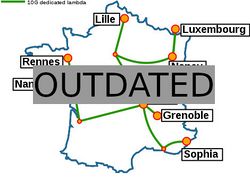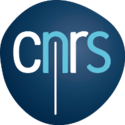Grid5000:Home: Difference between revisions
Ddelabroye (talk | contribs) No edit summary |
No edit summary |
||
| Line 7: | Line 7: | ||
Key features: | Key features: | ||
* provides '''access to a large amount of resources''': 1000 nodes, 8000 cores, grouped in homogeneous clusters, and featuring various technologies: 10G Ethernet, Infiniband, GPUs, Xeon PHI | * provides '''access to a large amount of resources''': 1000 nodes, 8000 cores, grouped in homogeneous clusters, and featuring various technologies: 10G Ethernet, Infiniband, Omnipath, GPUs, Xeon PHI | ||
* '''highly reconfigurable and controllable''': researchers can experiment with a fully customized software stack thanks to bare-metal deployment features, and can isolate their experiment at the networking layer | * '''highly reconfigurable and controllable''': researchers can experiment with a fully customized software stack thanks to bare-metal deployment features, and can isolate their experiment at the networking layer | ||
* '''advanced monitoring and measurement features for traces collection of networking and power consumption''', providing a deep understanding of experiments | * '''advanced monitoring and measurement features for traces collection of networking and power consumption''', providing a deep understanding of experiments | ||
Revision as of 09:25, 17 September 2018
|
Grid'5000 is a large-scale and versatile testbed for experiment-driven research in all areas of computer science, with a focus on parallel and distributed computing including Cloud, HPC and Big Data. Key features:
Older documents:
|
Random pick of publications
Five random publications that benefited from Grid'5000 (at least 2780 overall):
- Céline Acary-Robert, Emmanuel Agullo, Ludovic Courtès, Marek Felšöci, Konrad Hinsen, et al.. Guix-HPC Activity Report 2022–2023. Inria Bordeaux - Sud Ouest. 2024, pp.1-32. hal-04500140 view on HAL pdf
- William Mocaër, Eric Anquetil, Richard Kulpa. Early gesture detection in untrimmed streams: A controlled CTC approach for reliable decision-making. Pattern Recognition, 2024, pp.110733. 10.1016/j.patcog.2024.110733. hal-04634678 view on HAL pdf
- Fatmir Asllanaj, Sylvain Contassot-Vivier, Guilherme C Fraga, Francis H.R. França, Roberta J.C. da Fonseca. New gas radiation model of high accuracy based on the principle of weighted sum of gray gases. Journal of Quantitative Spectroscopy and Radiative Transfer, 2024, 315, pp.108887. 10.1016/j.jqsrt.2023.108887. hal-04375649 view on HAL pdf
- Daniel Rosendo, Marta Mattoso, Alexandru Costan, Renan Souza, Débora Pina, et al.. ProvLight: Efficient Workflow Provenance Capture on the Edge-to-Cloud Continuum. Cluster 2023 - IEEE International Conference on Cluster Computing, Oct 2023, Santa Fe, New Mexico, United States. pp.1-13. hal-04161546 view on HAL pdf
- Maxime Lanvin, Pierre-François Gimenez, Yufei Han, Frédéric Majorczyk, Ludovic Mé, et al.. Towards understanding alerts raised by unsupervised network intrusion detection systems. The 26th International Symposium on Research in Attacks, Intrusions and Defenses (RAID ), Oct 2023, Hong Kong China, France. pp.135-150, 10.1145/3607199.3607247. hal-04172470 view on HAL pdf
Latest news
Failed to load RSS feed from https://www.grid5000.fr/mediawiki/index.php?title=News&action=feed&feed=atom: Error parsing XML for RSS
Grid'5000 sites
Current funding
As from June 2008, Inria is the main contributor to Grid'5000 funding.
INRIA |
CNRS |
UniversitiesUniversité Grenoble Alpes, Grenoble INP |
Regional councilsAquitaine |


